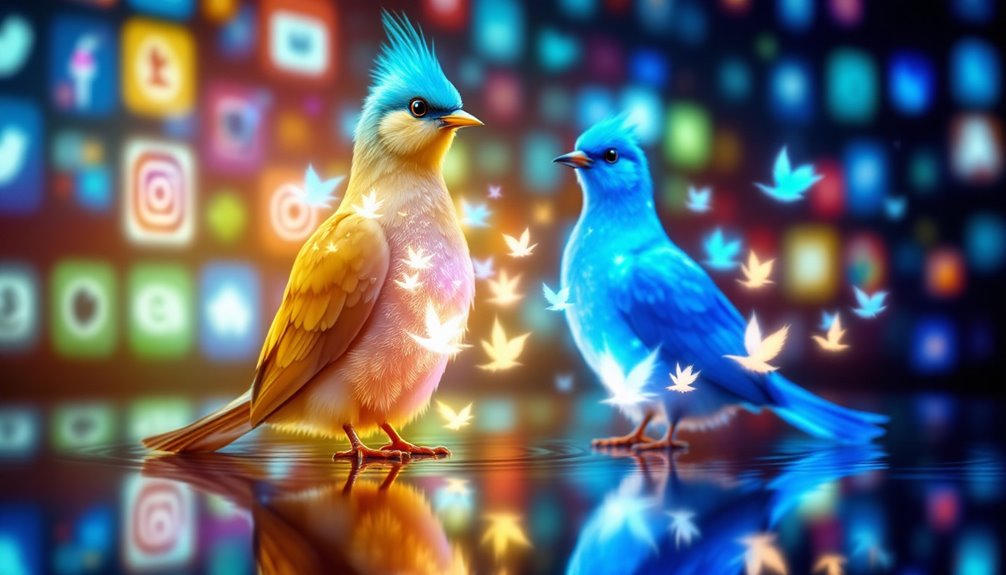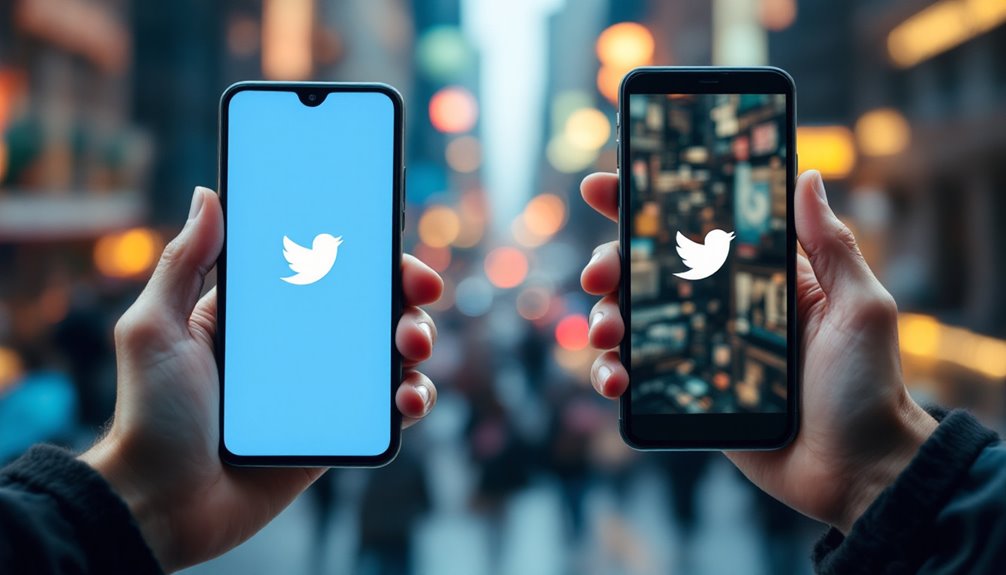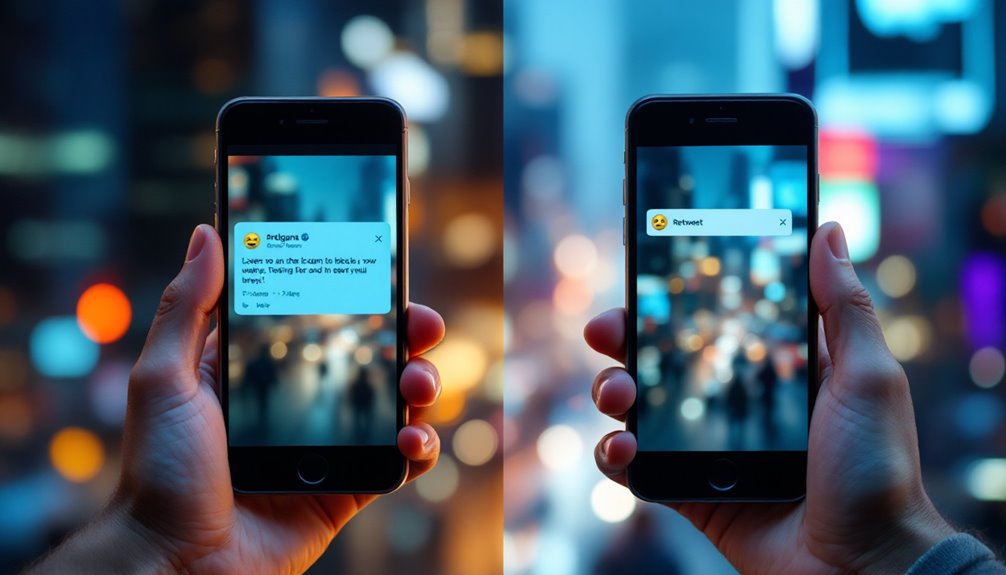
What’s the difference between a tweet and a retweet?
You’re scrolling through Twitter, and you notice a tweet that sparks your interest. You might wonder, what’s the real distinction between crafting your own tweet and simply hitting that retweet button? At first glance, it seems straightforward—one is your original thought, and the other shares someone else’s. However, the implications for engagement and visibility are far-reaching, influencing not just individual interactions but broader marketing strategies. Before you decide what to post next, consider how each action might shape your online presence and impact your audience. Curious about the dynamics at play? Let’s uncover the nuances together.
Key Takeaways
- A tweet is an original message limited to 280 characters, while a retweet shares someone else’s tweet to amplify reach.
- Tweets can include likes, replies, and foster direct engagement, while retweets focus on spreading existing content.
- Retweets retain the original author’s name and profile picture for proper identification.
- Retweets can be official or traditional, with official ones retaining original text and traditional ones possibly adding commentary.
- Retweets extend content visibility beyond the original audience, introducing it to new users and increasing engagement.
Definition and Purpose

When you’re exploring the world of Twitter, understanding the distinction between a tweet and a retweet is essential. A tweet is your digital canvas, limited to 280 characters, where you express opinions, share ideas, or promote news and products. With tweet characteristics that include text, links, images, GIFs, and videos, you can engage your audience creatively. Tweets are visible on your profile and the timelines of followers, inviting interaction through likes, replies, or retweets. They serve as a quick, efficient communication tool, ideal for real-time updates and fostering relationships with followers and experts alike. On the other hand, retweets hold significance in amplifying voices and enhancing connectivity. When you retweet, you share someone else’s tweet with your followers, extending the original message’s reach. This action can either be a straightforward share or include your commentary, known as quote tweeting. Retweets express support or agreement and play a strategic role in networking and spreading important information. They can make content viral, increase visibility, and align you with popular opinions or trends. Tweets also allow for engagement through mentions, where users can direct their tweets to specific individuals.
Visual Differences
When exploring the visual differences between tweets and retweets, you’ll notice distinct markers that help identify them in your timeline. Official retweets feature the original author’s name and profile picture prominently, while traditional retweets begin with “RT @username:” and may include added commentary. Retweeting is an essential tool for increasing the visibility of valuable information on Twitter. Quote tweets stand out with a distinct box around the original content, providing space for your comments above.
Timeline Display Differences
Though both tweets and retweets populate your timeline, they present distinct visual differences that affect how you interact with content. Understanding these differences can enhance your timeline visibility and overall experience.
Native retweets seamlessly integrate into your feed, displaying the original tweet as though you follow the original author. This dynamic guarantees a consistent format and appearance, preserving the tweet’s integrity while introducing new voices from users you don’t follow. The introduction of the retweet feature in August 2009 revolutionized how users could engage with content, allowing for easier sharing and discovery. Retweet dynamics allow you to engage with content beyond your immediate network, broadening your social media horizon.
In terms of timeline integration, native retweets appear based on the time of retweet, not the original posting time, yet they still show the original timestamp. This clever balance maintains chronological order in the “Following” tab while guaranteeing real-time content is prioritized.
The algorithm’s influence extends to the “For You” and “Explore” tabs, where retweeted content is selected based on engagement metrics and relevance, offering diverse content. Unlike manual retweets, which required cumbersome copying and pasting, native retweets maintain visual consistency, fostering a seamless user experience.
This innovation enhances your ability to discover and engage with fresh, relevant content effortlessly.
Retweet Identification Markers
Identifying retweets on Twitter involves recognizing specific markers that distinguish them from original tweets. Retweet mechanics and identification techniques have evolved with Twitter’s API updates, offering clear indicators.
In API v1.1, you’ll spot retweets by the ‘retweeted_status’ field and the “RT” prefix in the text. However, official retweets retain the original text without any added prefix, ensuring the original author’s words stay intact.
In API v2, identification techniques are streamlined, as retweets are marked by the ‘referenced_tweets.type’ field labeled “retweeted.” This update simplifies the process, eliminating the need for additional indicators. Visual differences also play a role: traditional retweets might include extra text or comments, whereas official retweets maintain the original message’s purity. The engagement metrics, such as likes and shares, can provide further insights into the interaction trends associated with retweets.
Here are three key points to help you identify retweets:
- Text Prefix: Traditional retweets might begin with “RT,” while official retweets show the original text unchanged.
- Author Attribution: Official retweets credit the original author, whereas traditional retweets can mention multiple users.
- Interaction and Sharing: Official retweets use a one-click button, differing from the manual effort required for traditional retweets.
Embrace these techniques to navigate Twitter’s retweet landscape effectively.
Engagement Opportunities

Engagement opportunities on Twitter are vast and varied, offering users multiple ways to interact with content and expand their reach. When it comes to tweet engagement, replying is a direct method to foster conversation. By hitting the reply button or starting a tweet with someone’s username, you can comment directly, facilitating interactive discussions.
Public replies, with a period before the username, guarantee broader visibility and help engage with customers, enhancing relationships and reach.
A retweet strategy is essential for sharing and amplifying content. Retweeting not only credits the original creator but also boosts your network, especially when users with large followings engage with your content. This reciprocal sharing can greatly enhance your Twitter presence, as retweeted tweets can reach an impressive audience quickly.
Adding a personal touch, quote tweets allow you to share content while embedding your commentary, sparking engaging conversations and debates. Quote tweets facilitate deeper engagement with the original content by allowing users to add their own perspectives while sharing.
Active strategies like asking for retweets or launching threads are powerful tools for increasing interaction. Running competitions and asking questions further invite engagement, making your tweet engagement strategy robust.
Timing your tweets strategically guarantees maximum reach and interaction, keeping your audience engaged and informed.
Increasing Visibility
Building on the array of engagement opportunities, let’s focus on increasing visibility through tweets and retweets.
Mastering visibility strategies is essential for amplifying your presence on Twitter. When you tweet, your message appears directly on your profile and is seen by your followers. It can spark conversations, attract new followers, and be discovered through hashtags and searches. Knowing differences between retweets and quoted tweets can further enhance brand communication, fostering better interaction with your audience.
Retweets, on the other hand, allow your content to reach beyond your initial audience, leveraging the networks of others to boost your visibility.
Here are three ways to enhance audience engagement through visibility:
- Utilize Hashtags: By incorporating relevant hashtags, you make your tweet discoverable to a wider audience who may be interested in the topic, not just your existing followers.
- Engage Influencers: If an influential user retweets your content, it can greatly amplify your reach and credibility, as their large follower base gains access to your message.
- Leverage Quote Tweets: These allow others to add their commentary, expanding your tweet into new discussions and threads, which can further increase visibility and engagement.
User Interaction Patterns

When you’re exploring Twitter, understanding user interaction patterns can transform your experience into one that’s more engaging and network-rich. By initiating conversations through tweets or retweets, you enhance your engagement and open doors to new networking opportunities. Whether you’re looking to start a discussion or amplify your reach, these interactions are key to a vibrant social media presence. Twitter’s role in science engagement shows that it is an important platform for science communication and outreach, allowing users to foster discussions and collaborations.
Conversation Starters
In the domain of social media interactions, especially on platforms like Twitter, conversation starters play a pivotal role in shaping user engagement patterns. They’re the spark that ignites dialogue and drives user interaction. Crafting the perfect conversation starter can enhance your social media presence, encouraging replies, retweets, and quote tweets. Here are some engagement tips to evaluate: Studies indicate a weak correlation between altmetric counts and traditional citations, suggesting they may only complement citation metrics. This highlights the importance of focusing on relevant discussions rather than sheer volume. 1. Ask Open-Ended Questions**: This invites followers to share their thoughts, sparking meaningful conversations. Questions like “What’s your favorite tech innovation?” encourage diverse responses. 2. Share Provocative Insights: Offer a unique perspective or a bold statement that challenges conventional thinking. This can prompt users to retweet or quote your tweet with their commentary, further expanding the conversation. 3. Use Polls and Surveys: These are interactive tools that not only encourage engagement but also provide valuable insights into your audience’s preferences and opinions. Incorporating these tips into your Twitter strategy can elevate your presence on the platform. By understanding and utilizing conversation patterns, you can predict interactions more accurately, leveraging different interaction types to foster a dynamic, engaging online community**. Innovate your approach, and watch your engagement soar!
Engagement Enhancement
Engagement on social media, particularly through platforms like Twitter, hinges on understanding and utilizing user interaction patterns effectively. To enhance audience engagement, you need to leverage the power of retweets, replies, and quote tweets.
Retweets greatly boost engagement metrics by increasing your content’s reach, potentially reaching 1,000 users beyond your followers, facilitating rapid information spread and enhancing your influence.
Replies, on the other hand, provide direct interaction, allowing you to engage openly with your audience. They’re perfect for building relationships and offering feedback, making them essential for brand engagement. Public replies can amplify your visibility, ensuring your responses are seen by more people, thereby enhancing engagement metrics.
Quote tweets give you the best of both worlds, combining sharing and commentary. They allow you to add personal insights, fostering interactive sharing that deepens audience engagement.
Networking Opportunities
To maximize networking opportunities on Twitter, understanding user interaction patterns is essential. By strategically following event organizers and participants, you can extend your networking reach post-event. This connection-building approach allows you to maintain and grow relationships even after the event has concluded. Event organizers often tweet updates and acknowledgments, providing opportunities for follow-up interactions with new contacts. Additionally, creating Twitter lists for clients, industry leaders, and favorite bloggers helps organize these essential contacts for easy access.
Consider these innovative networking strategies:
- Engage with Hashtags: Immerse yourself in conversations outside your immediate circle by using hashtags. Tools like TweetDeck can track real-time engagement, expanding your network effortlessly.
- Initiate Direct Conversations: Send direct messages to new followers. This personal touch can lead to deeper interactions, potentially evolving into phone calls or collaborations.
- Participate in Trending Topics: Contributing to popular discussions positions you as an industry thought leader and attracts like-minded individuals to your network.
Don’t forget to pin important tweets and keep your profile updated to maintain visibility.
Analyze your interactions, such as follows and replies, to predict and enhance future engagements. By mastering these networking strategies, you’ll thrive in the dynamic world of Twitter connection building.
Impact on Reach
The reach of a tweet is an essential factor in determining its impact on social media. When you post an original tweet, its reach is primarily limited to your followers, unless it gains traction through shares or retweets. You can elevate tweet reach by smartly using relevant hashtags, pushing beyond your immediate audience. However, original tweets lack the inherent network boost that retweets provide. Engagement like likes and replies are great but don’t expand your reach like retweets do. Retweets, on the other hand, reveal a powerful retweet influence. When someone retweets your content, it’s exposed to their followers, greatly amplifying the message’s reach. Even if your follower count is modest, a retweet can introduce your content to an average of 1,000 new users. If a retweet comes from a user with a substantial following, the potential reach skyrockets, enabling rapid information diffusion across the platform. Ultimately, understanding the dynamics of tweet reach and retweet influence helps you strategically amplify your social media presence. Keep in mind that the average of seven impressions is often needed for brand recall or purchase, highlighting the importance of repeated exposure. Use Twitter analytics to track and refine your approach, ensuring your content engages and reaches a wider audience effectively.
Behavioral Insights

With a keen understanding of what drives retweeting behavior, you can strategically enhance your content’s visibility. Retweeting is influenced by both altruistic and egoistic motivations. Altruistic retweets aim to spread valuable information and support others, driven by a desire to boost the original tweeter’s reputation and social capital. Egoistic retweets, however, focus on personal gain, such as gaining followers or reinforcing one’s identity. By aligning your content with these motivations, you can tap into the behavioral triggers that encourage users to share. Emotion plays a significant role in retweeting. Tweets that spark strong emotions like excitement or anger are more likely to be shared. This emotional charge acts as a powerful social influence, spreading content rapidly. However, it’s important to reflect on how impulsive emotional retweets can sometimes be regretted later, reminding you to think before sharing. Emotional content spreads faster than neutral messages, highlighting the instant gratification that often drives such behavior. Social context and norms also shape retweeting behavior. Conversations unfold across networks, and retweets invite new participants. To harness this social influence, think about these strategies:
- Use hashtags and URLs to increase retweetability.
- Engage in trending conversations to boost visibility.
- Attribute content clearly to maintain communicative fidelity.
Marketing Strategies
Understanding behavioral insights can reveal the power of retweeting, but mastering marketing strategies takes your Twitter game to the next level. Retweet strategies enhance engagement and reach by sharing the original tweet with your followers, expanding visibility and crediting the original user. This approach boosts your presence, especially if a user with a large following retweets you. It’s a quick content-sharing method, ideal for networking and contributing to overall engagement metrics like likes and comments.
Quote tweet advantages lie in their ability to customize and engage. By adding comments, images, or links, you create a new layer of interaction, encouraging conversations and increasing the original tweet’s visibility. This method enhances audience engagement more than simple retweets, as it alerts the original user and invites followers to interact with both your comments and the original content. Employing these strategies effectively can lead to increased engagement and retention, solidifying your presence on the platform.
Both strategies feed into analytics and impact. Retweets contribute to metrics like impressions, while quote tweets start new threads that can be tracked for interactions. These techniques help you understand what resonates with your audience, ultimately affecting the Twitter algorithm to enhance your content’s reach. Embrace these tools to innovate your Twitter marketing efforts.
Building Online Presence

Harness the power of an online presence by strategically identifying and targeting your audience. Start with platform selection; find where your audience hangs out—Twitter, Instagram, TikTok? Immerse yourself in demographic analysis to understand their age, gender, and interests. This helps you tailor content to maximize engagement.
Audience targeting is essential. Use segmentation tools to pinpoint your audience based on location, age, and interests. With this data, you can craft a content strategy that resonates.
Creating a compelling content strategy is your next step. Here’s how you can do it:
- Content Calendar: Organize and schedule posts for consistent, timely engagement.
- Engaging Content: Keep it fun, short, and filled with personality using images and videos.
- Content Themes: Plan themes to guarantee a cohesive brand image across your platforms.
But don’t stop there; engage actively! Build two-way relationships with your audience. Respond to comments and messages, and incorporate their feedback into your content strategy. A consistent engagement across multiple platforms enhances credibility, making your brand more trustworthy in the eyes of potential customers.
Setting SMART goals and analyzing performance metrics will help you refine your strategy. Use platform analytics to track success and adjust your approach, making sure your online presence is both dynamic and effective.
















